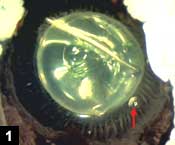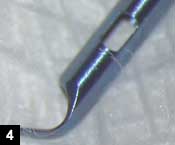‘Immobile movement’ concept enhances safety of bimanual microincision surgery
Standard maneuvers can damage the ciliary processes and cause consequent rupture of the blood-ocular barrier, two surgeons said.
Click Here to Manage Email Alerts
PARIS – A surgical technique based on “immobile movement” makes small-incision bimanual cataract surgery safer, avoiding often undetected trauma to the ciliary processes, according to two surgeons speaking at the meeting of the French Society of Ophthalmology.
 Philippe Sourdille |
“Damage to the ciliary processes is masked by the iris during surgery,” OSN Europe/Asia-Pacific Edition Editorial Board Member Philippe Sourdille, MD, said. “With the help of Miyake-Apple views, we found that elongation of the ciliary processes, and therefore rupture of the blood-ocular barrier, are caused by surgical maneuvers like capsulorrhexis, nucleus fragmentation, nucleus removal and IOL implantation.”
This damage can lead not only to transient complications but also to more severe consequences such as cystoid macular edema and retinal detachment, according to Dr. Sourdille.
“With this in mind, we have developed a surgical technique that has minimal repercussion on the anatomical structures of the eye at all stages of phacoemulsification,” he said.
All surgical maneuvers are performed bimanually through 1.2-mm microincisions.
“Two small incisions enhance anterior chamber stability and maintain a more constant IOP,” Dr. Sourdille said. In addition, the simultaneous presence of the two instruments in the anterior chamber allows for better-controlled maneuvers and minimal displacement of intraocular structures. Finally, the two opposite actions of infusion and aspiration and irrigation are more balanced when performed separately rather than at the extremity of the same cannula.
The innovative aspect of the new approach is the simultaneous presence of movement in the center of the capsular bag, to perform all the necessary surgical maneuvers, and immobility in the periphery, to prevent damage to the uveal structures, Dr. Sourdille said.
|
|
|
Capsulorrhexis and hydrodissection
Capsulorrhexis is performed with the aid of the cohesive-dispersive viscoelastic Rhéxéal (sodium hyaluronate, hypromellose, Corneal Laboratoires) without increasing the volume of the anterior chamber. The aqueous humor is slowly and regularly replaced by viscoelastic. A capsular incision is performed without creating folds in the anterior capsule. As demonstrated in Miyake-Apple views, there is no zonular displacement during this maneuver, according to Dr. Sourdille.
Hydrodissection can be the cause of considerable IOP increase because of the inflow of liquid in an anterior chamber that is already full of viscoelastic, he said. Pressures up to 80 mm Hg have been reported.
“To prevent IOP increase, the injection of liquid must be progressive and controlled, counterbalanced by an equivalent outflow of viscoelastic,” Christophe Poirier, MD, said. “At the same time, the nucleus should not be rotated, to avoid traction on the ciliary processes.”
He noted that a well-balanced irrigation is sufficient to separate the nucleus from the capsular bag. The liquid flow in the posterior nucleus-capsular bag interface is clearly visible with a normal cataract. In case of white or dense cataract, the anterior displacement of the detached nucleus will indicate that hydrodissection has been successfully completed.
Although the pumps that are currently available have reduced the risk of sudden modifications of volume and pressure in the anterior chamber, irrigation and aspiration is a delicate stage of cataract surgery, Dr. Poirier
Small incisions and bimanual technique play their most important role at this stage, enhancing anterior chamber stability.
“It makes sense to separate the two opposite actions of infusion and aspiration using two cannulas through the two ports rather than have them both in one phaco tip,” Dr. Poirier said.
Nucleus fragmentation and emulsification must be carried out with the minimum amount of time and power, remembering that the movement must be concentrated in the middle of the capsular bag, leaving an immobile periphery, he said.
|
|
|
|
Phacoemulsification and IOL implantation
“It’s at this stage that the risk of anatomical trauma is greatest,” Dr. Poirier said.
Most chopping instruments have 90° angled tips that can be cumbersome to maneuver through small incisions. In addition, their use is limited to nucleus fragmentation, he said.
“We have developed a special coaxial probe that is used during the entire process of nucleus fragmentation, including I&A. The tip is shaped like a small spatula, to hold the nucleus during chopping maneuvers and to help mobilize the fragments during aspiration,” Dr. Poirier said.
This allows the performance of minimal and better-controlled surgical maneuvers.
A flow rate of 26 mL/minute is used, with a linear aspiration up to 300 mm Hg to 350 mm Hg, according to the hardness of the nucleus. Only 30% phaco power is used, in the pulse mode, with a 20% repetition rate.
“Miyake-Apple views show clearly that at this stage the monomanual approach tends to cause displacement of the capsular bag, with consequent zonular stress. The reciprocal control of bimanual actions decreases this risk. The central movement does not extend to the periphery,” Dr. Sourdille said.
Fragmentation is carried out mechanically or with minimal ultrasound power. The probe is moved laterally to help with the fragmentation maneuvers, without rotating the nucleus. The same instrument is used to aspirate the nucleus fragments. Irrigation is maintained throughout the procedure, he said.
At the stage of IOL implantation, one of the two incisions is enlarged. The injector is placed in the center of the capsular bag to have symmetrical, simultaneous unfolding of the haptics, thus avoiding asymmetrical tractions to the capsular bag.
“The technique is simple and safe and only requires little changes in the standard maneuvers of bimanual cataract surgery,” Dr. Sourdille said. “These changes are based on the direct observation of the anatomical stress caused by routine surgery, on the awareness of its potential implications and on the attempt to eliminate all the unnecessary and potentially dangerous movements.”
For more information:
- Philippe Sourdille, MD, can be reached at Le Chaigne, 16120 Touzac, France; +33-630-362-846; e-mail: philippe.sourdille@wanadoo.fr. He is a consultant for Corneal Laboratories.
- Christophe Poirier, MD, can be reached at Polyclinique de l’Atlantique, La Rochelle, or Polyclinique Pasteur, Royan, France; e-mail: christophe.poirier@wanadoo.fr.
- Michela Cimberle is an OSN Correspondent based in Treviso, Italy, who covers all aspects of ophthalmology. She focuses geographically on Europe.





